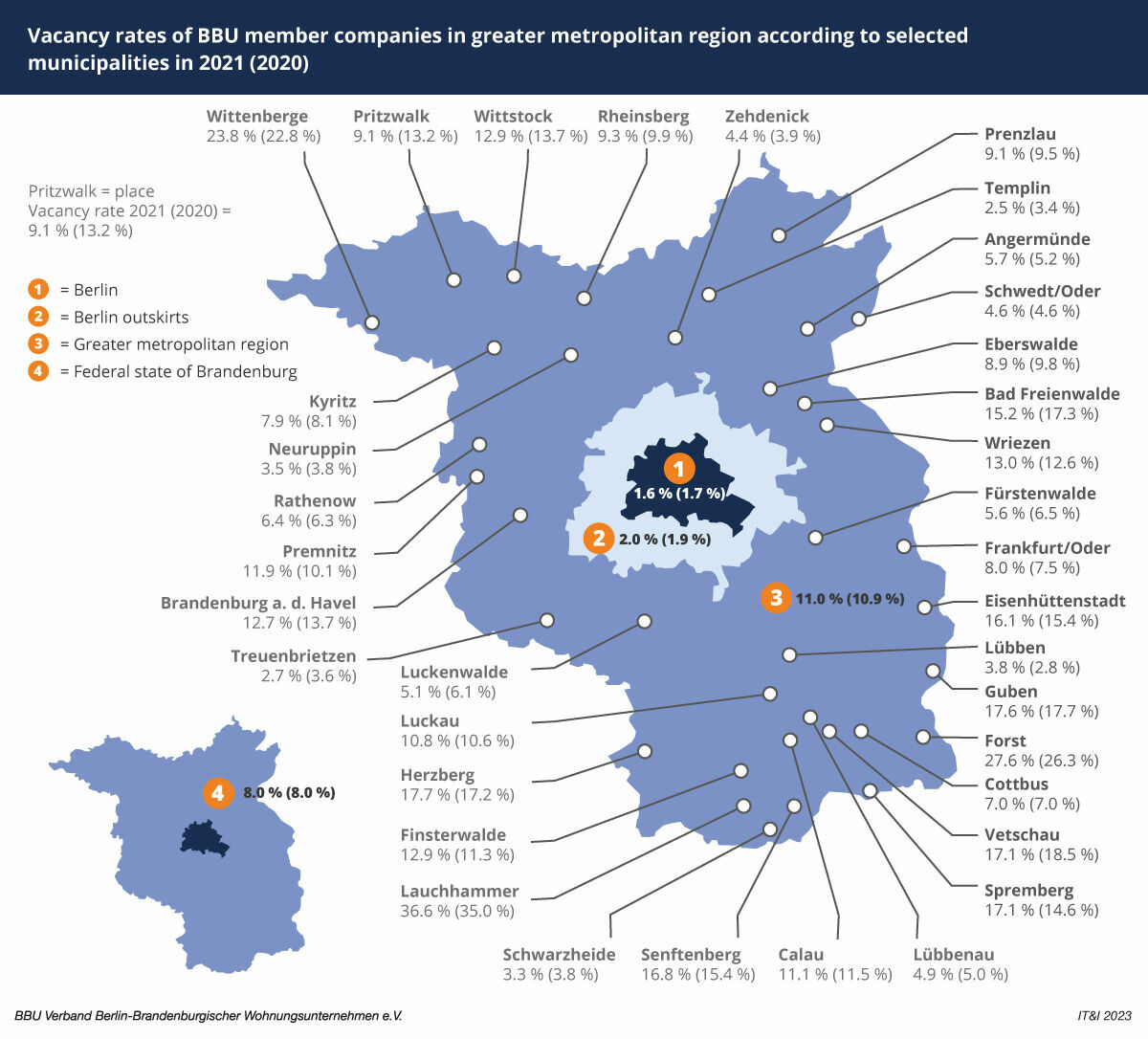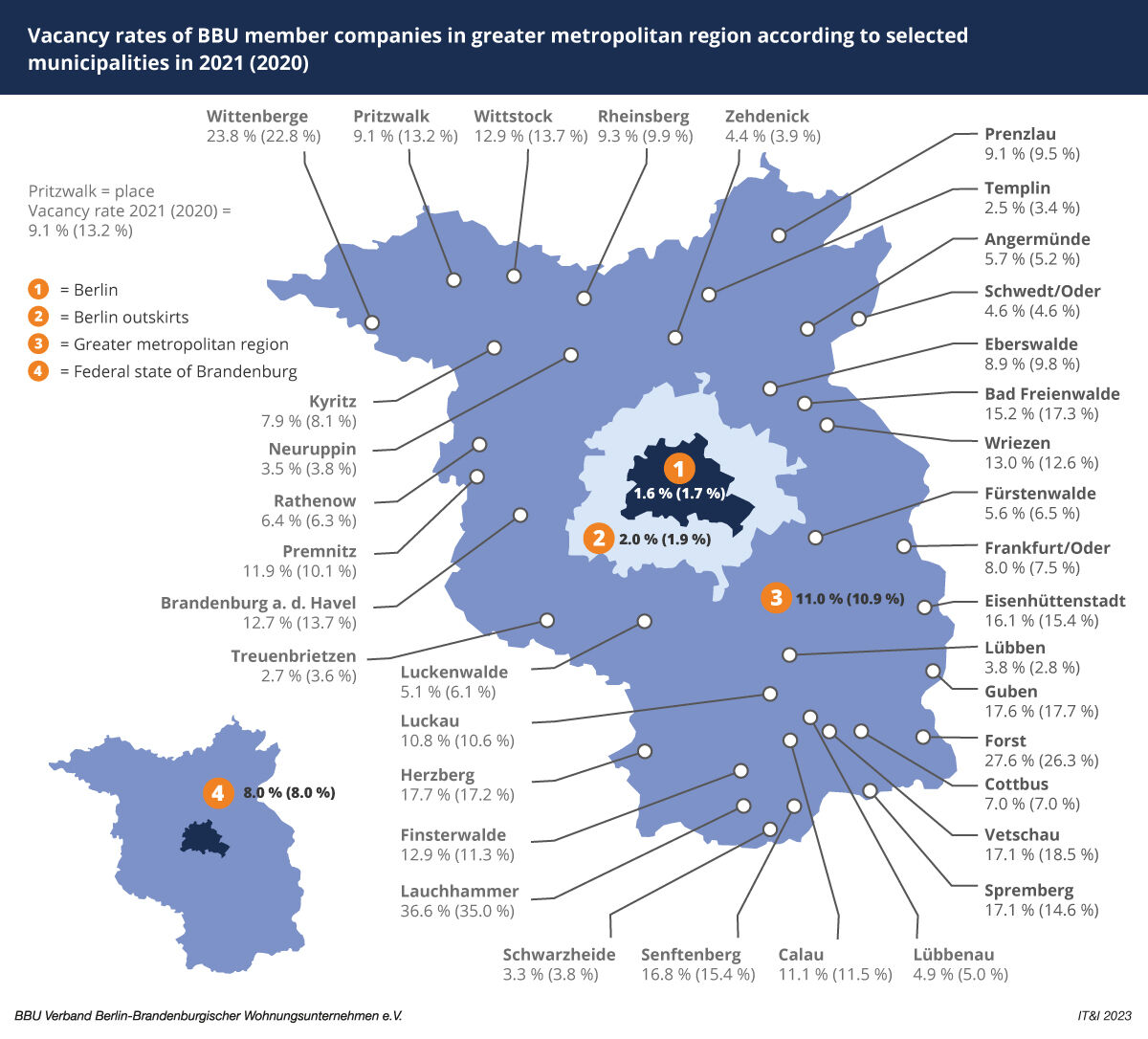We need to create additional housing – but how?
In this reflection, we look into the issue of providing affordable rental apartments to meet growing demand. Many problems come together here, because despite the high demand for housing, many properties are vacant. In particular, hardly any affordable rental apartments are available in popular major cities, while expensive rental apartments for tenants with higher to high incomes are not affected by this issue. Generally, the components discussed below have a major influence on housing construction.
Influencing factors on the housing market
The first, and probably most important, factor is Germany’s population, which has gone against the expected trend and increased considerably over the past few years. Currently some 84.4 million people live in Germany. On the other side of the equation, according to the Federal Office of Statistics, are approximately 43 million dwellings.[1] Demographically, the demand for housing is based on the number of adults and households. The German tenants’ association expects continued population growth over the coming years as well as a slightly rising tendency towards reducing average household sizes. As a result, the number of households and need for housing will increase.[2]
The second influencing factor is determined by immediate demand for housing, which amounted to around 700,000 apartments at the end of 2022. In dense urban regions and university towns, in particular, this demand can only be met inadequately in purely quantitative terms.[2]
The quality of the apartments on offer is the third and final aspect that is determined by the housing market. Some 10 percent of housing stock in Germany is considered incapable of being renovated, either from a technical or economic perspective, which widens the gap between supply and demand.[3]
The Federal Government has set itself the objective of building 400,000 dwellings per year to compensate for the deficit. However, since it can be foreseen that this target will be missed again in 2023, it makes sense to look to unconventional ideas and new, intelligent solution strategies. Some of these are presented below.[4]

Figure 1: Vacancies are increasing sharply in some German municipalities.
 Figure 1: Vacancies are increasing sharply in some German municipalities. |
Potential solutions for more housing and fewer vacancies
An important adjusting mechanism to accelerate the creation of new housing is the time required to establish the planning regulations and have construction projects approved. The time required varies greatly and depends on a variety of factors, including the size and complexity of the project, agreement of the involved authorities and compliance with regulations and approval procedures. There are also the issues of potential objections from local residents and environmental concerns. Germany does not have any country-wide deadlines or regulations for the approval of construction projects. However, in some federal states it is possible to make use of accelerated procedures. There is also the option to bring actions for failure to act against authorities. Applicants can shorten the wait time by submitting their applications in full the first time and ensuring that no exceptions need to be approved.[5]
Flat shares and the construction of new, bigger flats or houses for large families are good solutions to allow living in shared housing. However, these are not options for everyone and it is difficult for outsiders to influence these factors. This approach would also have an effect on household sizes, which directly impacts the housing industry data: demand for housing increases when the average number of household members decreases, but if flat shares increase then the number of households will, in turn, decrease.
Residential vacancies in rural regions
On the flip side of demand for housing in major cities is a much larger housing supply in rural regions. In many cases, there is a well-established system of public transport to the urban centres. This is generally accepted knowledge, but attempts to close this gap between housing supply and demand have been largely unsuccessful. Potentials can be leveraged here: the Deutschland-Ticket for €49 per month allows people to rent affordable housing within range of the scheduled public transport in the vicinity of metropolitan areas. The low rent makes up for the time required to travel to the place of work in the city centre. Ideally, the desired digitalisation should allow everyone to work while commuting by bus or train. Here, a good infrastructure is required to avoid overcrowding of public transport and ensure a reliable mobile phone network or WiFi connection in all locations. The lack of retail offerings in the vicinity of the housing can also be compensated through online portals. Working from home creates the opportunity to avoid travelling to work every day, although this is not possible for all industrial workplaces or the service provision sector. Not all the available housing in the countryside is in an acceptable technical state. Here, too, models can be developed so that renovation work performed by tenants results in decreased rent.
Home exchanges
Another possibility for moving into a new residence is home exchanges. For this, people who wish to move from a small flat to a larger one must find someone who wants to move from their large dwelling into a smaller place. Berlin’s state-owned housing company supports home exchanges as a sensible component of needs-based supply of housing. The special feature here is that the exchange does not change the net rent without utilities.[6] Older inhabitants of a large flat often have an old rental contract with a cheaper rental progression, which the younger tenant can take over following the home exchange. This does not create new housing, but satisfies the demand in a targeted way.

Figure 2: Loft conversions can create additional housing.
Extending living space
Many large families live in small flats, and are desperate to find a larger place to live. This is another area where large letting companies must act. If tenant living in the immediate vicinity of the occupied small flat – on the same floor, for example – gives notice, this flat should be offered to the large family. If the flat being vacated is directly adjacent, a wall breakthrough could immediately create a larger flat. This makes the supply of housing more flexible and meets tenants’ demands more easily.
Loft conversions
There is great potential for retroactive densification of existing buildings through the addition of another storey or conversion of previously unused loft spaces. According to a survey by the Berlin Senate Department, some 52,000 dwellings could be created through adding an extra story or converting the lofts of rented residential buildings constructed between 1920 and 1930. The structure of such buildings is more suitable than that of post-war buildings, which have lower roof spaces. This would require the approval authorities of the Berlin districts to support such considerations without bureaucracy.[7]
The benefits are clear: realising such projects is more cost-effective than constructing new buildings since there are no costs for acquiring land and infrastructure services. From an urban planning perspective, some 330 discount food retailers, supermarkets and self-service department stores would be suitable for addition of an extra storey, which would create up to 36,000 apartments. There are many positive aspects to this multi-purpose use of buildings. For example, the shops are in good locations and already perfectly integrated into a social infrastructure and public transport services.
Rent control creates affordable housing
The federal states allow landlords to acquire rent and occupancy control agreements at attractive conditions for existing buildings or to extend expiring control agreements. With this fixed-duration support, landlords could reduce the rent for this housing to up to €3 per square metre of living space. At the same time, they could reserve flats in all locations for rent control agreements at short notice, thus ensuring a better mix of tenants in a neighbourhood. This financing potential is also available in the federal states’ budgets because the funds for constructing new housing are not fully used up. This will alleviate the situation regarding rents for existing housing stock.
Conclusion
Although the number of vacant residences throughout Germany is considerably higher than the demand for rental apartments, more new residential buildings need to be constructed in order to create housing for potential tenants and purchasers, especially in popular areas. However, realising this will take a long time and, once it is complete, it is possible that the demand for housing may have decreased at that location. This, in turn, is an economic risk for landlords.
Unconventional methods make more sense here to provide relief. The geographical areas in which the demand for housing can be met should be viewed with a larger scope, meaning not just looking at the neighbourhood or urban district, but also adjacent neighbourhoods in less populated regions that bring their own advantages.
- https://www.destatis.de/DE/Presse/Pressemitteilungen/2023/07/PD23_297_31231.html
- https://www.mieterbund.de/fileadmin/public/Studien/Studie_-_Bauen_und_Wohnen_in_ der_Krise.pdf
- morgenpost.de/wirtschaft/article237340905/ wohnen-wohnungsnot-neubau-wohnungs- bau-deutschland.html
- https://www.tagesschau.de/wirtschaft/wohnungsbau-bundesregierung-101.html
- https://www.wohnung.com/ratgeber/2507/ wie-lange-darf-die-bewilligung-einer-bauge- nehmigung-dauern
- https://inberlinwohnen.de/wohnungstausch/
- https://www.berliner-mieterverein.de/maga- zin/online/mm1116/dachgeschossausbau- und-aufstockung-viel-potenzial-oberhalb- der-traufe-111620.htm & https://www.welt.de/finanzen/immobilien/ article185180520/Neuer-Wohnraum-Unterm-Giebel-ist-noch-Platz.html
Author:

Ernst Hubert von Michaelis
Sales Representative
PROMOS consult
Other articles by this author:
- Article "We need to create additional housing – but how?"
- Article "The metropolis of the future – a discussion article"
- Article "Co-working – Find a workspace and network at the click of a mouse"
- Article "Less is more – an alternative way of living"
- Article "Micro living – the future of living as a new asset class"
- Article "The digitisation of retail – in-store, online, mobile... Wasted opportunities or risks?"
- Article "Accounting for leasing relationships in accordance with the IFRS 16 standard with low administrative expense"
- Article "Working from home is passé... the new trend is working on the move"
- Article "All that is possible with individual mobility"


